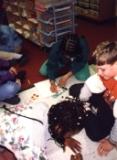
“How many students should be in a group?”
The PGCPS website [http://www.pgcps.org/~elc/learning1.html] gives this simple and easy to understand description for small groups:
Size
The smallest group is two. The largest recommended is six. Generally, in smaller groups each member participates more, fewer social skills are required, and groups can work more quickly. Larger groups generate more ideas, deal better with complex ideas, and create fewer group reports to process. Remember, it’s hard to get left out of a pair; triads tend to surface issues and are good for process observing; teams of four allow multiple ways to pair.
Formation
With a few exceptions, research favors groups which are heterogeneous with regard to academic achievement, gender, ethnicity, task orientation, ability, and learning style. Heterogeneous groups promote more elaborate thinking and explanations, and provide opportunities for students to develop feelings of mutual concern. Student self-selection of groups is generally not successful, although students may provide input for teachers to consider in assigning groups. Random assignment promotes the idea that everyone is expected to work with everyone else at some point. Random assignment can result in teams that are not heterogeneous or equal in ability, so are best used if the task is of short duration.
Duration
If the task is of some duration, the makeup of groups must be seen as “fair,” so the groups should be carefully structured. Groups that stay together for longer periods (4-6 weeks) form stronger bonds, develop more complex collaborative skills, and can tackle more complex tasks. Groups should remain together long enough to feel successful, but not so long that bonds become counter-productive. It is a usually a mistake to break groups up because they are having trouble functioning since members will feel unsuccessful in groups and transfer that feeling to the next group. Try to establish some success first!
Let me add the variations I have made to survive. When I taught a class of almost 40 students I divided my class into 4 groups because that’s the number of groups I could best manage for the amount of time I had allotted for mathematics. It also made it where I could use 4 stations easily.
I put multiple sets of same activities or games in each of the stations so that, at the most, 4 students would be working together on an activity. The leader took ½ of the group and the co-leader took the other half. (One teacher mentioned to me that I really sometimes had 8 groups but 2 at a time were going to each station. That’s one way to look at it… and, if it works for you, think about it that way!)
One of the most important things to remember about grouping is to “shake up” or vary the way students experience a concept. Students should have the opportunity to learn in a whole-group setting, working with a partner, in a small group with varied levels of understanding, and in a group with students who are at the same level for the specific concepts being studied.
How will you shake up the grouping of students in your class in 2011?

